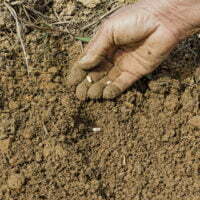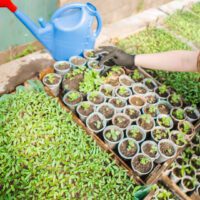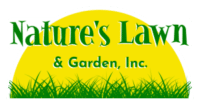What’s the Best Way to Plant a Garden?
One question frequently asked by new gardeners is: what’s the best way to plant a garden? Should you direct-sow seeds in the garden, start them inside to transplant later, or simply purchase starter plants from a garden center? In today’s blog post, we’ll discuss the benefits of each option to help guide your decision!
When you direct-sow seeds, you plant the seeds straight into your garden’s soil. There’s no need to start seeds indoors and relocate them later–where you plant them is where they will grow and stay, unless you choose to thin them after the seeds have sprouted.
Transplanting involves starting seeds in one location and later relocating them into your garden. You can either start your own seeds indoors and transplant them, or you can purchase starter plants from your local nursery.
Before you “spring ahead” into outdoor gardening, consider:

Advantages & Challenges
- Direct sowing is a much simpler process than transplanting – you don’t have to start seeds early or worry about supplies like a heat mat and grow light. You can sow seeds right into the ground, water, and watch ‘em grow. Starting plants from seed allows you more options. You can browse different varieties in seed catalogs rather than being limited to whatever transplants your local garden center offers. Starting from seed is also cost-effective, especially if you’re growing large quantities or plan to grow in succession.
- There are many benefits to starting seeds indoors. In many regions there are not enough growing days for some plants to get to harvest if they’re started outside. Starting seeds indoors will give a few extra weeks of growing time, which can really make a difference. When you plant your own seeds, you tend to have healthier starts, since you can give them extra care from day one. To improve germination rates, consider using our Super Humic Acid from the start.
- Starter plants can give you more predictable results in the garden – they’re started by professionals in ideal conditions to create hardy, healthy, young plants; they mature sooner, giving you an earlier harvest; they can also be more resistant to insects because they’re stronger when you first put them into your garden. If you don’t have the time or desire to start your own, buying transplants is a great way to support local farmers and garden centers!
Soil Preparation
No matter what method you choose to grow your garden from, you’ll need to prepare the soil in your garden:
- Start by cleaning up your garden bed. Remove any debris or weeds that managed to survive the winter. Weeds will compete with your plants for space, sunlight, and nutrients.
- Take the time to prep your soil. Seeds need to be able to break through the soil when they germinate, so soft, well-aerated soil is essential. You don’t want to till the soil too much, though, as this can cause clumping, compaction, and loss of beneficial soil bacteria. We recommend a liquid aerator like Aerify Plus to keep the soil loose and break down clay and compaction.
- Once the soil is cleaned up and loosened, perform any soil testing that you need to do. Check the pH (most garden soil should be slightly acidic, around 6.5 for most vegetable plants) and should have plenty of nutrients in it. If you need to amend your soil, do that before putting your seeds/transplants into the ground.
- It’s always a good idea to add organic matter to your garden beds before planting such as compost. But not everyone has room for a compost bin, or wants to deal with shoveling a truckload of compost from the driveway to your garden beds. Nature’s Magic is the perfect liquid alternative, adding concentrated organic matter, molasses, and humic & fulvic acids to the soil in seconds, without the hassle of heavy (often smelly) compost.
Transplant Preparation
- Be sure to “harden off” your transplants – expose them to slightly cooler and dryer conditions before putting them out into your garden. Most transplants have been grown in controlled environments, with warm temperatures and plenty of water. If you set them right out into your garden, they may suffer shock from the sudden changes.
- Additionally, running a fan to blow light air over your transplants will strengthen their stems and stalks and prevent them from snapping with the first strong wind.
- Make sure to thoroughly water your plants before removing them from their original container.
Planting Your Garden
- For direct-sowing seeds, check your seed packet for planting information, including how deep to plant your seeds, how far to space them out, and how long you can expect it to take them to germinate. Sow your seeds according to the directions on the packet. Seed catalogs will recommend whether to start seeds indoors or to sow directly into the soil.
- For transplants, dig a hole that is larger than the size of the container the plant was in. Gently break up the soil around the roots to loosen them up before placing it into the hole.
- Cover the roots loosely with soil and water deeply. Add soil as needed to fill in the soil.
What Plants Can You Direct Sow?
Plants that are quick to germinate are great to start from seed:
- Beans
- Beets
- Carrots
- Marigolds
- Melons
- Morning Glory
- Peas
- Radish
- Spinach
- Squashes
- Sunflowers
- Turnips
- Zinnias
- Zucchini
What Plants Should You Transplant or Start Indoors?
- Broccoli
- Celery
- Collards
- Eggplant
- Impatiens
- Kale
- Kohlrabi
- Leeks
- Onion
- Pansies
- Peppers
- Petunias
- Scallions
- Snapdragon
- Tomatoes
As you can see, the best way to plant a garden depends on a lot of different factors! Many plants grow perfectly well when started outdoors and even prefer not to be transplanted. Ultimately, it’s important to consider how each type of plant grows in addition to where you’re growing it. Keep in mind that there isn’t a strict rule about what you can start indoors and outdoors; it will vary by your experience, your personal preference, your location, and the plant itself.
Have fun and get growing!




